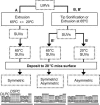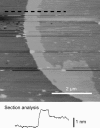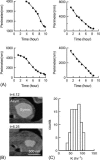Lipid asymmetry in DLPC/DSPC-supported lipid bilayers: a combined AFM and fluorescence microscopy study
- PMID: 16214871
- PMCID: PMC1367021
- DOI: 10.1529/biophysj.105.067066
Lipid asymmetry in DLPC/DSPC-supported lipid bilayers: a combined AFM and fluorescence microscopy study
Abstract
A fundamental attribute of cell membranes is transmembrane asymmetry, specifically the formation of ordered phase domains in one leaflet that are compositionally different from the opposing leaflet of the bilayer. Using model membrane systems, many previous studies have demonstrated the formation of ordered phase domains that display complete transmembrane symmetry; but there have been few reports on the more biologically relevant asymmetric membrane structures. Here we report on a combined atomic force microscopy and fluorescence microscopy study whereby we observe three different states of transmembrane symmetry in phase-separated supported lipid bilayers formed by vesicle fusion. We find that if the leaflets differ in gel-phase area fraction, then the smaller domains in one leaflet are in registry with the larger domains in the other leaflet and the system is dynamic. In a presumed lipid flip-flop process similar to Ostwald ripening, the smaller domains in one leaflet erode away whereas the large domains in the other leaflet grow until complete compositional asymmetry is reached and remains stable. We have quantified this evolution and determined that the lipid flip-flop event happens most frequently at the interface between symmetric and asymmetric DSPC domains. If both leaflets have identical area fraction of gel-phase, gel-phase domains are in registry and are static in comparison to the first state. The stability of these three DSPC domain distributions, the degree of registry observed, and the domain immobility have biological significance with regards to maintenance of lipid asymmetry in living cell membranes, communication between inner leaflet and outer leaflet, membrane adhesion, and raft mobility.
Figures







Similar articles
-
Drying and rehydration of DLPC/DSPC symmetric and asymmetric supported lipid bilayers: a combined AFM and fluorescence microscopy study.Langmuir. 2008 Sep 16;24(18):10371-81. doi: 10.1021/la8016694. Epub 2008 Aug 16. Langmuir. 2008. PMID: 18707144
-
Transbilayer effects of raft-like lipid domains in asymmetric planar bilayers measured by single molecule tracking.Biophys J. 2006 Nov 1;91(9):3313-26. doi: 10.1529/biophysj.106.091421. Epub 2006 Aug 11. Biophys J. 2006. PMID: 16905614 Free PMC article.
-
Nano-mechanical characterization of asymmetric DLPC/DSPC supported lipid bilayers.Chem Phys Lipids. 2021 Jan;234:105007. doi: 10.1016/j.chemphyslip.2020.105007. Epub 2020 Nov 5. Chem Phys Lipids. 2021. PMID: 33160952
-
Lipid domains in supported lipid bilayer for atomic force microscopy.Methods Mol Biol. 2007;400:503-13. doi: 10.1007/978-1-59745-519-0_34. Methods Mol Biol. 2007. PMID: 17951756 Review.
-
Lipid Self-Assemblies under the Atomic Force Microscope.Int J Mol Sci. 2021 Sep 18;22(18):10085. doi: 10.3390/ijms221810085. Int J Mol Sci. 2021. PMID: 34576248 Free PMC article. Review.
Cited by
-
Relaxation dynamics of two-component fluid bilayer membranes.Eur Phys J E Soft Matter. 2016 May;39(5):52. doi: 10.1140/epje/i2016-16052-3. Epub 2016 May 6. Eur Phys J E Soft Matter. 2016. PMID: 27145960
-
Effects of Passive Phospholipid Flip-Flop and Asymmetric External Fields on Bilayer Phase Equilibria.Biophys J. 2018 Nov 20;115(10):1956-1965. doi: 10.1016/j.bpj.2018.10.003. Epub 2018 Oct 10. Biophys J. 2018. PMID: 30393103 Free PMC article.
-
Asymmetric Hybrid Polymer-Lipid Giant Vesicles as Cell Membrane Mimics.Adv Sci (Weinh). 2017 Dec 5;5(1):1700453. doi: 10.1002/advs.201700453. eCollection 2018 Jan. Adv Sci (Weinh). 2017. PMID: 29375971 Free PMC article.
-
Effects of lipid composition and phase on the membrane interaction of the prion peptide 106-126 amide.Biophys J. 2009 Jun 3;96(11):4610-21. doi: 10.1016/j.bpj.2009.01.036. Biophys J. 2009. PMID: 19486683 Free PMC article.
-
Nanoscale imaging reveals laterally expanding antimicrobial pores in lipid bilayers.Proc Natl Acad Sci U S A. 2013 May 28;110(22):8918-23. doi: 10.1073/pnas.1222824110. Epub 2013 May 13. Proc Natl Acad Sci U S A. 2013. PMID: 23671080 Free PMC article.
References
-
- Brown, D. A., and E. London. 2000. Structure and function of sphingolipid- and cholesterol-rich membrane rafts. J. Biol. Chem. 275:17221–17224 [Review]. - PubMed
-
- Devaux, P. F., and R. Morris. 2004. Transmembrane asymmetry and lateral domains in biological membranes. Traffic. 5:241–246. - PubMed
-
- Devaux, P. F. 1991. Static and dynamic lipid asymmetry in cell membranes. Biochemistry. 30:1163–1173. - PubMed
-
- Daleke, D. L. 2003. Regulation of transbilayer plasma membrane phospholipid asymmetry. J. Lipid Res. 44:233–242. - PubMed
-
- Kornberg, R. D., and H. M. McConnell. 1971. Inside-outside transitions of phospholipids in vesicle membranes. Biochemistry. 10:1111–1120. - PubMed
Publication types
MeSH terms
Substances
LinkOut - more resources
Full Text Sources
Other Literature Sources
Miscellaneous

